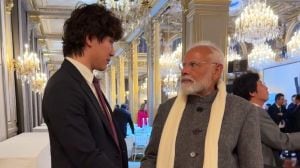This year, India is expecting the return of a 500-year-old bronze idol of a Hindu saint Tirumankai Alvar, believed to be stolen from a temple in Tamil Nadu, after a formal request was made by the Indian government to the Ashmolean Museum of Art and Archaeology in Oxford, UK, which has been housing the ancient artefact since 1967.Similarly, in August last year, a limestone sculpture, originating from Andhra Pradesh, and in 2019, a Navaneetha Krishna sculpture originating from 17th-century Tamil Nadu, were handed over to the Indian High Commissioner to the UK following a joint US-UK investigation involving Scotland Yard.
There have been several instances of stolen artefacts being restored from other countries, highlighting the growing awareness and sensitivity towards cultural restitution. However, experts say this is just the tip of the iceberg. Throughout history, dozens of artworks have been stolen from galleries, collections and studios but are yet to be returned to the country of origin.
Take for instance, the Koh-i-Noor, one of the largest cut diamonds in the world. The 105.6-carat diamond, worth $591 million, was found in the Kollur mine of Andhra Pradesh between the 12th and 14th centuries during the Kakatiya dynasty rule. However, it travelled through several Indian dynasties, before ending up with the British colonial empire and currently housed at the Tower of London.The sword of Tipu Sultan, dating to his reign between 1782 and 1799, changed many hands before being acquired by Vijay Mallya in 2004 for `1.5 crore. It was ‘given away’ in 2016 before being auctioned for `143 crore last year. Similarly, Maharaja Ranjit Singh’s golden throne is now housed in the Victoria and Albert Museum, London, and the Eliot Marbles, also called the Amaravati sculptures, occupy a pride of place in the British Museum.
If we estimate the number of stolen items in India alone, as reported by the Economic Advisory Council to the PM in 2022, between 1992 and 2017, over 4,408 items were stolen from monuments across India, but only a third were intercepted by the police. It is also estimated that over 10,000 major works of art, along with allegedly stolen antiquities, have been smuggled from India every decade since the 1950s.The antiquities market is estimated to be worth $300 million-$6 billion a year, according to author Roger Atwood’s 2020 book Stealing History. Unesco reports that the illicit trade in cultural goods—of which antiquities trafficking is a part—is worth $10 billion a year.As the art fraternity and activists flag the issue of how such disputed objects should go back to their countries of origin, and getting the treasured objects back is a symbolic win for many countries, the procedure has its own set of challenges.
Take for instance, the 2012 UN report that evaluated the effectiveness of the Unesco 1970 convention, a pioneer in the fight against the illicit trafficking of cultural property. The report states how the convention strongly lacked resources and laws to back it up.
The art world, too, questions if the countries of origin have the resources for proper care and preservation. “The British Museum is the museum of the world as they have got objects from Greece to Egypt. Don’t we have objects from all across the world, too, in our museums? While we are respectful of each other, it is an advantage for our country that more people are looking at it, enjoying the beauty and heritage of India,” adds Delhi-based art historian-curator Alka Pande.On the other hand, while there are unequal power dynamics between Western countries and the Global South, including the art world, returning artefacts to their places of origin helps to restore their cultural, historical and spiritual significance, which might have been lost or misunderstood in foreign contexts.
“A lot of Western museums have excellent facilities to preserve artefacts, but in the more recent past, institutions in India are building conservation labs, and offer training opportunities for conservation and museum staff. It is equally important to support the Global South in building educational programmes, offering exchange programmes, passing on expertise, and supporting cultural institutions to care for these artefacts. While some of this is already happening, much more is required,” says Shibu Narayan, head of collections at the Museum of Art & Photography (MAP) in Bengaluru.Even if artworks, which have been wrongly removed, should be restituted to the nation of origin, regardless of whether that nation has the infrastructure to properly care for and hold them, officials of private museums like MAP in Bengaluru feel the evaluation and repatriation of looted artworks can significantly help countries, both in terms of goodwill between nations and to restore and reaffirm cultural heritage, cultural identity and history.
“In instances of the country of origin lacking the infrastructure to care for them, the reparation process should include support from nations having the knowledge and infrastructure for the care of these artefacts. Historically, Western institutions have held vast collections of artefacts of non-Western origin, often acquired during periods of colonial expansion. Repatriation efforts challenge these dynamics and push for a more equitable distribution of cultural heritage,” says Narayan.
Moral, legal grounds
India had passed a law before independence, an antiquities (export control) act in April 1947, to ensure that “no antiquity could be exported without licence”. In 1958, the Ancient Monuments and Archaeological Sites and Remains Act was enacted. The government also enacted the Antiquities and Art Treasures Act, 1972 (AATA), where “every person who owns, controls or is in possession of any antiquity” shall register such antiquity before the registering officer “and obtain a certificate in token of such registration”. But the Antiquities and Art Treasures Act, 1972, implemented in 1976, strictly banned the export of any sort of archaeological object and also imposed stricter vigilance on individual ownerships of such objects. In short, all archaeological objects and sites were taken under state possession. Under this rule as well, attempts were made to get stolen antiquities back.
India has been at the forefront of the repatriation but one needs to have sufficient ground to show that particular antiquity was stolen from a site in India, or the antiquity belongs to India. Dr BR Mani, director general of the National Museum in Delhi, says, “Thousands of antiquities in the past have gone to many foreign countries but there should be sufficient ground to prove it like FIRs or complaints. Only in that case can we get the antiquities restored to our country, or otherwise in the case of antiquities which have been stolen after the enactment of The Antiquities and Art Treasures Act, 1972.”The artworks confiscated or acquired by individuals of the colonial rule to their country are a case in history to bring them back. “In post-interdependent India when private dealers and agents, even after laws were passed, were stealing antiquities from temples, from architectural heritage sites and selling them abroad, those items / works should definitely be brought back because there is a moral issue attached to it,” says Pande.
She states that India has witnessed an increasing demand for the repatriation of looted art objects globally. “Even as the British Museum in London continues to be in denial of its legacy of loot, from the Elgin marbles from Parthenon in Greece to the Elliot marbles from Amaravati in India, the idea of universal museums of the West continue to be hotly debated and challenged,” she says.
The power dynamics of the countries that have looted artworks are aptly explained in The Journal of Asian Studies titled Indian Art Objects as Loot, in which author Richard H Davis states how in the medieval period the sacred objects were looted from their original locations and demolished. The looted items demonstrated the looter’s power.
According to former culture secretary and MP Jawhar Sircar, India has been at both receiving and gaining end when it comes to repatriation of looted art objects. “At the receiving end, since India was under colonial rule, they could take whatever they felt like. And the other end was that they also set up museums in India like the oldest museum in Asia was in Calcutta, the Indian Museum, which is now 210 years old,” says Sircar.
For many years, India was under an amnesia, and the sudden proprietary-ism is healthy and welcoming. “If we look at the 19th and 20th century, when people became interested in museums and history, there is no evidence of public exhibitions of antiquities. What every nation required was an institution to showcase achievements and historical development. Every nation had at least one National Museum. While the West had taken away many edifices from Asia and Africa, they cared better for their booty, and displayed them better than the countries that lost them,” adds Sircar.
In fact, India didn’t have a clue about its own masterpieces. The first two major discoveries of British archaeology—the Amaravati stupa, which Colonel Mackenzie had stumbled upon in 1798, and the Ajanta caves, which were discovered accidentally by a team of soldiers in 1819—are two of the grandest evidences of the efflorescence of Buddhist art and culture that had lapsed from human memory, as per Sircar.
India’s biggest haul of its antiquities last year was from the US, which offered 1,440 artefacts for repatriation. The objects were stolen from sites across states and smuggled out of the country over the decades. Since Independence, around 350 heritage objects have been brought back from different countries including France, Germany, Singapore, Australia and Canada. According to the ministry, around 190 were retrieved from the US. The arrival has increased since 2014 as only 13 objects could be fetched since 1947.
As per government officials, this kind of repatriation takes longer than usual and happens for over a period of months due to cumbersome financial and administrative clearances. “The agency has to decide the cost of insurance, packaging and transportation cost,” says a government official on the condition of anonymity.
Most articles were smuggled by the notorious New York-based art dealer, Subhash Kapoor, who is currently serving a jail term in Tamil Nadu.
The Union ministry of culture estimates a total of 115 antiquities were returned to India in 2023, and 344 since 2014. The ministry is also working to ensure retrieval of about 700 pieces belonging to the Aural Stein Collection of Central Asian antiquities, actually owned by the Archaeological Survey of India (ASI). The collection was lent to the Victoria and Albert (L&A) Museum in London about 100 years ago. The National Gallery of Australia (NGA) is also expected to return 13 artworks it purchased from Kapoor, which include six sculptures, six photographs, a painted scroll and a processional standard.
Global initiatives
People like Gliceria Tupinamba are at the forefront of flagging the issue of looted treasures. At this year’s Venice Biennale, Tupinamba was the first indigenous artist to represent the native American history and colonial exploitation. A multicoloured mantle (feathered cape) constructed using 4,200 feathers and a wall text explain that seven European museums still hold mantles in their collections. Last year, Denmark’s National Museum announced that it would return one cape to Brazil, but it still holds others. The restitution of feathered capes from European museums to Brazil clearly means the battle to have their ancestors back.
The biennale is also hosting Nigerian artists like Yinka Shonibare, who has made intricate artefacts in clay, which replicate 150 Benin Bronzes—priceless artefacts looted in 1897 by the British soldiers and now housed in European and American collections. Abba Tijani, director general of Nigeria’s National Commission for Museums and Monuments, wants the ‘Benin bronzes’ from the 19th century back. “We want to give museums the opportunity to return these artworks to their rightful owners and exhibit them legally—to do the right thing,” says Tijani.
It is indeed the awareness of past cultural injustices and renewed respect for national sovereignty that has made nations housing stolen art or other items give back the artefacts. French President Emmanuel Macron, while addressing a crowded lecture theatre at Ouagadougou University in 2017, said, “I cannot accept that a large part of cultural heritage from several African countries is in France … In the next five years, I want the conditions to be created for the temporary or permanent restitution of African patrimony to Africa… African heritage can no longer be the prisoner of European museums.”
So far, France has repatriated 28 African objects including a 19th-century sabre to Senegal. The country has also returned the crown of Madagascar’s last queen, Ranavalona III, as a long-term loan from France’s Army Museum via diplomatic channels, bypassing Parliament.









